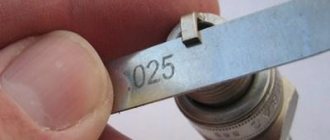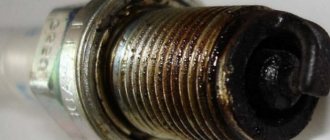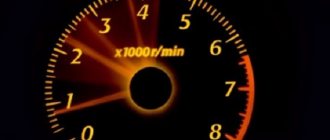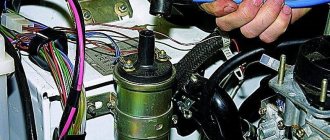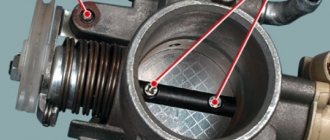Surely every car owner has experienced such an unpleasant situation when the car stalls when releasing the gas.
This problem is one of several most common. To begin with, I would like to clarify why the engine may be plugged during a reset. The very first and most common problem is the banal clogging of the gap in the throttle valve. Another equally popular problem is the dying of the regulator, and they can break quite often.
It’s not uncommon to hear from people that it got to the point where they had to completely change it. Or some people benefit from a very serious and deep flush.
Causes of failure
Before you start repairing your car, you should find out the cause of the problem, and they can be different:
- Most often, the car stalls after filling with low-quality fuel. In this case, the throttle valve becomes clogged.
- The cause may be a failure of the throttle position sensor. By the way, such sensors break quite often, so their replacement may be frequent, especially considering the quality of spare parts that are sold today.
- Some owners do not look for the cause, but immediately flush the entire system, and if flushing does not help, then they delve deeper into the problem.
Throttle valve
If after all the checks and measurements carried out above it was not possible to identify a malfunction, then all that remains is to check the condition of the throttle valve assembly. To do this, the part should be dismantled and then cleaned of dirt using cotton swabs. The cleaned part (or rather, all its pipes and tubules) is blown with compressed air using a compressor.
Special attention should be paid to the channel that serves to remove gases from the crankcase. Before starting purging, it should be filled with a cleaning compound and allowed to stand for some time, after which the purging itself should be performed. This is caused by the extremely small diameter of the internal channel, as a result of which other methods of cleaning it are simply not available.
In addition to all of the above breakdowns, a breakdown of the DPKV sensor, as well as the Hall sensor, can also lead to “floating” speed. If they fail, the Check Engine light will light up on the car panel. If such a malfunction occurs, it is best to contact a service center, since special equipment is required to check these sensors.
Sensors
- Idling. This idle speed sensor is installed to control the engine. It is used in cars to achieve stable engine operation and stable idle speed. Often the RPM readings can be unstable and fluctuate. At that moment, the engine may stall if you take your foot off the gas. If there is such a problem, then you can be almost 100% sure that it lies precisely in such a detail. And repairs should begin with the replacement of this part. The sensor works on the principle of supplying air to the engine to maintain stable idle speed. It is very important for the operation of the entire fuel system, which supplies fuel to the engine. The sensor also affects the injection operation. Once it is contaminated, the machine will operate unstably.
- You should also pay attention to the air flow element. It is located in a similar system, but a similar sensor is responsible for more significant work. He is responsible for more operations. If such a sensor stops working as expected, the cause may be poor quality fuel. Therefore, it may make sense to change the gas station or gasoline that the car is fueled with.
Car stalls when you let off the gas
- Registration
- Entrance
- To the beginning of the forum
- Forum Rules
- Old design
- FAQ
- Search
- Users
- List of forums AUTOLADA.RU
- Family "Samara"
I have encountered this situation on three occasions.
1) The idle speed solenoid valve or the idle speed relay is faulty. This is checked by unscrewing it and uncoupling the copper jet. If after this you go to change either the valve or the idle speed relay, or plug it in and drive like that, the consumption will increase by 200-500 grams per hundred km 2) The mixture is too lean. If you haven’t turned the carb with a screwdriver before, then this is probably irrelevant.
3) Low fuel level in the carburetor. Here you need to adjust it, in my opinion, by bending the float tongue.
90 percent of the reason is point 1. Check it, then do the rest
When the valve is usually faulty, it stalls like this: you drive, drive, then, for example, you press neutral and release the gas, the engine stalls and all the lights come on. But it's running on choke
Could this be due to the fact that there is no corrugated hose? On the air filter that goes.
Could this be due to the fact that there is no corrugated hose? On the air filter that goes.
I don't have a thermostat in front of the pan. Just a saucepan. What is the name of the hose from the garbage that is screwed to the manifold, which is inserted into the thermostat and sucks out warm air? In principle, I think it’s possible for the winter without the corrugation, just plug in this hose.
I don't have a thermostat in front of the pan.
_________________ POD
grow
O L
cherish
SK
porosity
!
Freedom for parrots and c105!
Could this be due to the fact that there is no corrugated hose? On the air filter that goes.
Oh well... this can't be true. I’ve never had a cardboard corrugation and the thermocouple died 20 years ago, always open directly. Starts and runs even at -30/-35
How can the fitting be unscrewed? How then does the carb heat itself? My car is now running at -20 in the morning, so hot that I’m driving with the window slightly open, and then the Carlson is triggered (although there is a sensor from the classics) The carb is hot, I don’t believe that it could freeze over due to the corrugations
I don't have a thermostat in front of the pan. Just a saucepan. What is the name of the hose from the garbage that is screwed to the manifold, which is inserted into the thermostat and sucks out warm air? In principle, I think it’s possible for the winter without the corrugation, just plug in this hose.
I don't have a thermostat in front of the pan. Just a saucepan. What is the name of the hose from the garbage that is screwed to the manifold, which is inserted into the thermostat and sucks out warm air? In principle, I think it’s possible for the winter without the corrugation, just plug in this hose.
I don't have a thermostat! Its remains even more so. I just have a pan standing there, without anything, with a hole where to stick this thermostat! T 808. The thermostat costs 650 rubles. Pipe 50. Either spend 700 rubles, or 50, and the output is the same. The only thing is to remove this pipe by summer and that’s it. The question remains. Nothing will happen if the pipe is connected directly to the pan without a thermostat from the manifold?
+ besides, it’s not a fact that after this everything will be normal, so I’m not very willing to spend 700 rubles just on hope.
It’s not a fact that things will be fine after this,
First check the fuel jet of the XX system, the bronze piece of garbage at the end of the EMC. Unscrew the valve and remove the jet from it. Blow out the nozzle and channel XX with compressed air (pump, compressor). Just check the valve itself. Turn on the ignition, put the wire on the valve terminal and attach it to ground (engine, carb). See if the needle is retracted inward. If not, temporarily before replacing the valve, bite the needle so that it does not block the nozzle hole. Put everything in its place and try.
See if the needle is retracted inward. If not, temporarily before replacing the valve, bite the needle so that it does not block the nozzle hole. Put everything in its place and try.
I think if the problem was in the jets, valves, etc., then it would have been at a higher temperature.
If it clicks, change the control unit
_________________ God bless me in a cool, dry place!
Today we were driving along the highway, 90-100 km/h. At the end of the highway there is a traffic light, we start to slow down, the car stalls. We stopped, started up, drove off, let off the gas - it stalled. And so seven times, as soon as you let off the gas, it immediately stalls. The econometric arrow is on the left edge (in the yellow zone) when the car stalls, all the red lights on the panel are on (low panel). (nine car, 1.5l carb). Then they started using the handbrake in a traffic jam and did not let go of the gas, after 2 minutes the stalling stopped. What can be wrong? This is a problem only when you drive at high speed for some time. This has never happened in the city! So it’s not gasoline, the air filter is a week old, the ignition was turned on recently, the tank is not empty, the fuel pump is good. What else could it be? PS: could this be due to the fact that there is no corrugated hose? On the air filter that goes.
Other problems and solutions
Quite often, cars can stall due to a faulty computer. Incorrect operation may be due to incorrect programming at the factory. In this case, it is recommended to flash the processor with updates. This work can be done by service station technicians.
There are frequent cases of engine stalling caused by a contaminated catalyst. To check, it is recommended to drive the car for a long time, then, after it gets dark, park the car and look under it. If the catalytic converter starts to glow, most likely the problem is a clogged one.
If the EGR valve is broken, the car may idle poorly and stall. If there is such a breakdown, then an error code number P1406 often appears. To normalize operation, you can replace it or simply clean it from dirt.
When the machine is faulty, it is recommended to check the injectors for functionality.
Maybe they are the problem. They can often become clogged, causing the car to stall. You can use a multi-purpose lubricant to clean the injectors. After washing, you should check the operation of the car.
Spark plug
The first thing worth checking when looking for the reasons for floating speed on a VAZ 2114 (injector) is the spark plugs. Unscrew them and inspect their condition. They should not be oxidized, uneven soot, oil, etc. They should have a brown or gray-brown soot, without any deposits. If so, the spark plugs are in working order. In cases where the replacement took place a long time ago, it is more advisable to immediately replace them with new ones, regardless of the condition. Remember that spark plugs need to be replaced every 20-30 thousand kilometers. If a warmed-up engine returns to normal operation, then this is another sign to look for a problem in the spark plugs.
Service visit
All the procedures that have been discussed can be done by a person who is familiar with car repairs. But, as a rule, beginners will not be able to find even the XX sensor. If you don’t have enough knowledge, then it’s better not to get into the engine and its system yourself, but to turn to specialists. Intervention on your own can only cause more harm. The cost of repair work in the service may vary. It all depends on why the engine stalls. Maybe it will cost by washing the parts, or maybe even more expensive engine repairs.
Wear of sealing gaskets
The design feature of the engine requires the presence of sealing gaskets. They make the engine structure more airtight. If the gaskets in the area of the manifold or cylinder block are worn out or have lost their tightness, then when you press the gas pedal, the engine may stall.
If the gasket burns out, coolant penetrates into the engine in the area of the cylinder block. In this situation, the engine continues to operate, but the number of revolutions decreases sharply. You may notice white smoke coming from the exhaust pipe.
The driver, faced with the problem of turning off the engine, finds himself in an extremely unpleasant situation. In order to eliminate this difficulty, you need to know the reason for its occurrence.
Eventually
It is worth noting that sometimes in case of the described breakdowns it is better to call a tow truck or ask friends to tow the car to the station. If the car can still drive itself, then, of course, you can drive to the service station on your own.
Surely every car owner has experienced such an unpleasant situation when the car stalls when releasing the gas. This problem is one of several most common. To begin with, I would like to clarify why the engine may be plugged during a reset.
The very first and most common problem is the banal clogging of the gap in the throttle valve. Another equally popular problem is the dying of the regulator, and they can break quite often.
It’s not uncommon to hear from people that it got to the point where they had to completely change it. Or some people benefit from a very serious and deep flush.
After revving the VAZ 2114, the speed drops
Hi all. We have the following problem: a VAZ-2114 car, manufactured in 2007, mileage 80,000 km, with power consumers (headlights, heater, etc.) on, the car almost stalls when the gas is released, the revolutions drop to 400-500. If you turn everything off, the motor works as it should. If you remove the wires from the generator, then everything works fine, because of this, the first thing they did was change the generator, it didn’t help. Then it was replaced: (or checked) IAC (2 times) DMRV spark plugs Measured compression (everywhere 12) Measured pressure in the fuel rail (about 3 points) Removed the fuel pump to check the mesh (perfectly clean) Reflashed the ECU Straightened the mass on the body, engine, ECU The throttle has been washed. There seems to be no air leakage from the mass air flow sensor to the throttle. Charging OK
Nothing helped! There is a suspicion that the 1st injector is faulty, because... In the 1st cylinder the spark plug is all smoked.
For clarity, I am posting a video of a faulty car (link No. 1) and for an example video (link No. 2) of the same car with all power consumers turned on (the standard, as it should be :))
Source
Problems and their solutions
The car stalls when you let off the gas - but what exactly lies behind this problem? Everything is quite simple, after reaching a certain speed, the foot is removed from the gas pedal and the car simply stalls. With all this, when the ignition is applied and at idle, everything works more than with a bang.
Despite the advice given above, the problem may not be solved, since they are general preventive measures for a stalled engine. As for the problem itself, it’s worth paying attention to several sensors.
After revving the VAZ 2114, the speed drops
Hi all. We have the following problem: a VAZ-2114 car, manufactured in 2007, mileage 80,000 km, with power consumers (headlights, heater, etc.) on, the car almost stalls when the gas is released, the revolutions drop to 400-500. If you turn everything off, the motor works as it should. If you remove the wires from the generator, then everything works fine, because of this, the first thing they did was change the generator, it didn’t help. Then it was replaced: (or checked) IAC (2 times) DMRV spark plugs Measured compression (everywhere 12) Measured pressure in the fuel rail (about 3 points) Removed the fuel pump to check the mesh (perfectly clean) Reflashed the ECU Straightened the mass on the body, engine, ECU The throttle has been washed. There seems to be no air leakage from the mass air flow sensor to the throttle. Charging OK
Nothing helped! There is a suspicion that the 1st injector is faulty, because... In the 1st cylinder the spark plug is all smoked.
For clarity, I am posting a video of a faulty car (link No. 1) and for an example video (link No. 2) of the same car with all power consumers turned on (the standard, as it should be :))
Source
Sensors
The first of them is the idle speed sensor. This device is located in the engine control system. It is used in cars to stabilize idle speed. Its abrupt performance often precedes the engine turning off when the gas pedal is released. If this is exactly the sequence, then with a 90% probability this particular sensor is involved and you need to start digging in its direction.
As you can understand, this sensor is designed to supply air to the engine to maintain normal idle speed. This sensor is a very important component of the entire fuel supply system to the engine, and it works closely with the injection system.
Car stalls when you let off the gas
Messages: 5240 Registered: 08 Oct 2008, 00:00 From: TYUMEN Experience: 12 years Car: TIIDA :
Awards: 1
| Rating: 18 740 |
| Reputation: +31 |
Thanked: 47 times Thanked: 208 times
- Quote
Post by ALEXX_72 » Jan 25, 2010, 05:43 pm
Yastrebov72, most likely the HBO is not adjusted. If there is not enough gas supply, the car will stall. In short, you need to look AS ALWAYS, the problem is one, there are many advisers. Here either the brakes stall even on gasoline or the LPG is not configured, IMHO
Added after 1 minute 35 seconds:
Re: Periodically stalls at idle when driving on gas.
[quote="SergeiMark2"] The problem is the following - for example, when braking in front of a traffic light. quote] I thought that this operation meant pressing the brake pedal, or you were releasing the anchor
| Rating: 27 210 |
| Reputation: +36 |
Thanked: 212 times Thanked: 177 times
- Quote
Post by Yastrebov72 » Jan 25, 2010, 05:47 pm
Other reasons and their solutions
Another reason may be the wedge of the XX valve. This problem can be temporarily solved by simply tightening the throttle cable a little. Then see what happens. The notorious XX sensor can also be involved here. It also contains more than a dozen problems, but most of them can be solved by simple washing.
It is the sensor that is washed
, or to be more precise, its components in the form of a needle and its hole where it enters. Checking its functionality is quite simple, you need to remove the sensor itself, activate the connector, then disconnect the battery for a short period of time, then connect it again and turn on the ignition, you will see how the needle begins to make forward-return movements.
Another reason could be the battery terminal. In order for everything to be in order, it needs to be reset, so that it can incorrectly transfer data to the engine control settings.
This procedure resets all system settings, and it will again learn to gain and maintain the correct idle speed, and only 3-5 trips may be enough for this. This does not always happen, but still, such a process is called “self-learning”.
It is also possible, and even necessary, to check the injectors; it is possible that the problem lies in their contamination or even technical wear, and, as a result, in their malfunction. Read the article “How to clean injectors.”
Washing everything and everyone should be done exclusively with WD-40 washing liquid.
How to check the fuel system?
The fuel system contains many elements and parts that can stop working at any time. Some nodes cannot cope with high loads. At this moment the car stalls when you press the gas. The engine stops working due to a small amount of fuel in the combustion chamber. In this case, it is recommended to check the fuel pump. This is done using a pressure gauge and supplying power to the pump. If the fuel pump is working properly, the pressure gauge will show a figure equal to 2.7 atmospheres. Slight deviations in one direction or the other are allowed. If the number is significantly lower, then the problem is a faulty pump - it needs to be replaced. For domestic cars it is inexpensive - about 1 thousand rubles.
When the car stalls when you sharply press the gas, this is one of the most possible reasons. Malfunctions often occur in the injectors - they spray a combustible mixture into the engine cylinders. They can fail due to the quality of the fuel. Low-quality gasoline contains impurities that pass through the filter. They clog the injector nozzles. It will not be possible to test the injectors in a garage; you need a special stand.
You can try to perform independent diagnostics, but for this the injector must really be broken. For the test, unscrew the fuel rail. The nozzles are retracted to the other side of the engine, and then the starter is fired. In this case, the fuel must be atomized - if gasoline flows or drips, the injectors must be changed. A poor level of atomization can also lead to problems when the car stalls when you press the gas.
A trip to the workshop
As you can see, everything described above can be done by a person who knows the structure of the car, but there is nothing for a beginner, because not every novice car enthusiast knows where the XX valve is located, much less its sensor. There is a high probability that outside interference will only make everything worse, or will break or spoil something that was originally in working order. So here it’s worth setting priorities and logically assessing your chances of correcting all problems yourself.
Naturally, in moments when the car stalls when releasing the gas, few people are interested in why this is happening, so it would be very advisable to call a tow truck and tow the car for repairs, or, if the situation is not completely dire, then you can drive to the repair shop yourself .
The price for correcting problems will directly depend on their cause; if it is a simple flushing of sensors and valves, then it will not be very high.
VK CHANNEL GROUP - vk.com/garagr29 I'M ON DRIVE2 -www.drive2.ru/users/onega-sever/#blog INSTAGRAM-GARAZHR29
Topic: when I let off the gas, the car stalls and doesn't idle
Theme Options
- print version
- Send by email...
Display
Linear view
- Combined view
- Tree view
I let off the gas, the car stalls, the idle does not hold
friends, help, I have a Camry 25, American, automatic transmission, 2001. — I start it, it starts and stalls, the idle doesn’t hold at all, I start it and keep it on the gas, the car is running, everything is fine, I let off the gas, the car stalls and that’s it
What did you do? Why are the symptoms like this? Read the thread about cleaning the throttle valve, then if you have any more questions, write.
I support, after cleaning the maf and throttle the issue should go away
I had this happen once when I forgot to put the vacuum hose from the crankcase ventilation on the tube, I got scared, I thought I was being silly, I drove the car away, together with the brake pedal (to turn it on, I held the gas so that it didn’t stall, and so I drove off ha ha ha, minutes after 10 I remembered, understood, forgave
This requires cleaning the idle air valve, located under the throttle assembly. There are a lot of topics on cleaning in the search. Good luck.
+100. The same nonsense happened on 20, I cleaned it and everything was gone for 20 thousand.
Topic information
Checking the fuel pump
The main indicator of the performance of the fuel pump is the gasoline pressure in the fuel rail. Methods of connecting to the fuel line:
- using a standard fitting to measure pressure in the rail. This type of power system is installed on VAZ 8-valve internal combustion engines with a fuel return line from the rack to the gas tank. You can connect the pressure gauge through an adapter that screws onto a fitting with an external thread. Inside the fitting there is a spool valve, reminiscent of a bicycle valve, which, when pressed, communicates with the fuel rail and pressure gauge hose. But not all cars have a factory connector for connecting a pressure gauge. And in some cases the adapter itself is more difficult to find than to make a device for direct connection;
- connection contrary to the fuel line. You will need: a pressure gauge with a measurement scale of up to 7 kg/cm², a fuel hose of a suitable diameter, a tee and 2 fittings (“male” and “female” quick-release type) for connecting standard pipes. Such a simple device will allow you to crash into the fuel line, while maintaining the ability to start the engine.
There are a large number of ready-made kits for measuring fuel pressure in the rail on sale. But purchasing it is not practical for one-time use. The high cost is due to the many different fittings and adapters for connecting to the main types of power systems. If you are considering purchasing such a kit, make sure that it has the necessary adapters to connect to your car.

